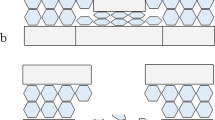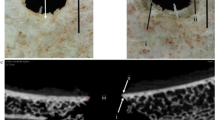Abstract
When perforated by a projectile, sandwich bones typically exhibit wounds with a distinct conoidal morphology that is widely utilised both in wound diagnosis and trajectory determinations. However, the dynamic fracture mechanisms underlying this intriguing wound type have yet to be experimentally verified. The most frequently quoted hypothesis for their formation, plug and spall, is difficult to reconcile with the conoidal morphology exhibited by such wounds. The present article carries out a high-speed videographic and micro-computerised tomographic (μ-CT) analysis of perpendicularly produced projectile wounds induced from 139.15 to 896.84 metres per second (m/s) in pig scapulae. Fundamental data on energy absorption, wound shape and bevel symmetry are presented. Cross-sectional fracture morphology revealed by μ-CT raises the novel hypothesis that tensile stresses induced by the projectile in the outer cortex elicit cone crack formation and that this cone crack then propagates catastrophically through the entire sandwich structure. This process results in the momentary formation of a bioceramic conoid, a conoidal volume of bone consisting of all three sandwich bone layers separated from the parent bone by the internal bevel. Fragmentation of the separated volume leaves the conoidal wound behind as its counterpart. The significance of this hypothesis in terms of differential diagnosis and interpretation of bevel shape is discussed.








Similar content being viewed by others
References
Maiden N (2009) Ballistics reviews: mechanisms of bullet wound trauma. Forensic Sci Med Pathol 5:204–209. https://doi.org/10.1007/s12024-009-9096-6
Aarabi B, Tofighi B, Kufera JA, Hadley J, Ahn ES, Cooper C, Malik JM, Naff NJ, Chang L, Radley M, Kheder A, Uscinski RH (2014) Predictors of outcome in civilian gunshot wounds to the head. J Neurosurg 120:1138–1146
Mota A, Klug WS, Ortiz M, Pandolfi A (2003) Finite-element simulation of firearm injury to the human cranium. Comput Mech 31:115–121. https://doi.org/10.1007/s00466-002-0398-8
Snell RS (1995) Clinical anatomy. Lipincott Williams and Wilkins, Maryland
Berryman HE, Symes SA (1998) Recognising gunshot and cranial trauma through fracture interpretation. In: Reichs KJ (ed) Forensic osteology: advances in the identification of human remains. Charles C Thomas Publishers, Springfield, pp 333–352
Rhine and Curran (1990) Multiple gunshot wounds to the head: an anthropological review. J Forensic Sci 35(3):1236–1245
Spitz WU (2006) Injuries by gunfire. In: Spitz WU, Spitz DJ, Clark R (eds) Spitz and Fisher’s medicolegal investigation of death: guidelines for the application of pathology to crime investigation. Charles C Thomas Publishers, Springfield Available from: Proquest Ebook Central. Accessed 9.11.17
Hull D (1999) Fractography: observing, measuring and interpreting fracture surface topography. Cambridge University Press, Cambridge
Komar DA, Buikstra JE (2008) Forensic anthropology: contemporary theory and practice. Oxford University Press Inc., New York
Symes SA, L’Abbé EN, Chapman EN, Wolff I, Dirkmaat DC (2012) Interpreting traumatic injuries to bone in medicolegal investigations. In: Dirkmaat DC (ed) A companion to forensic anthropology. Wiley-Blackwell Publishing, West Sussex
Christensen AM, Passalacqua NV, Bartelink EJ (2014) Forensic anthropology: current methods and practice. Academic Press, Oxford
Peterson BL (1991) External beveling of cranial gunshot entrance wounds. J Forensic Sci 36(5):1592–1595
Kimmerle EH, Baraybar JP (2008) Skeletal trauma: identification of injuries resulting from human rights abuses and armed conflict. CRC Press, Florida
Kieser JA, Tahere J, Agnew C et al (2011) Morphoscopic analysis of experimentally produced bony wounds from low velocity ballistic impact. Forensic Sci Med Pathol 7:322–332. https://doi.org/10.1007/s12024-011-9240-y
Murphy MS, Gaither C, Goycochea E, Verano JW, Cock G (2010) Violence and weapon-related trauma at Puruchuko-Huaquerones, Peru. Am J Phys Anthropol 142:636–649
Murphy MS, Spatola B, Weathermon R (2014) Allies today, enemies tomorrow: a comparative analysis of perimortem injuries along the biomechanical continuum. In: Martin DL, Anderson CP (eds) Bioarchaeological and forensic perspectives on violence: how violent death is interpreted from skeletal remains. Cambridge University Press, Cambridge, pp 261–288
Bird CE, Fleischman JM (2015) A rare case of an intact bone plug associated with a gunshot exit wound. J Forensic Sci 60(4):1074–1077
Smith MJ, Brickley MB, Leach SL (2007) Experimental evidence for lithic projectile injuries: improving identification of an under-recognised phenomenon. J Archaeol Sci 34:540–553
Rickman JM, Smith MJ (2014) Scanning electron microscope analysis of gunshot defects to bone: an underutilised source of information on ballistic trauma. J Forensic Sci 59(6):1473–1486. https://doi.org/10.1111/1556-4029.12522
Currey JD (2002) Bones: structure and mechanics. Princeton University Press, New Jersey
Quatrehomme G, İşcan MY (1998) Analysis of bevelling in gunshot entrance wounds. Forensic Sci Int 93:45–60
Zukas JA (1982) Penetration and perforation of solids. In: Zukas JA, Nicholas T, Swift HF, Greszczuk LB, Curran DR (eds) Impact dynamics. John Wiley and Sons, Inc., USA, pp 155–214
Backman ME, Goldsmith W (1978) The mechanics of penetration of projectiles into targets. Int J Eng Sci 16:1–99
Crouch IG (2016) An introduction to armour materials. In Crouch IG, Arthur J (eds) The science of armour materials, available from ProQuest Ebook central
Hassan MZ, Cantwell WJ (2012) The influence of core properties on the perforation resistance of sandwich structures: an experimental study. Compos Part B 43:3231–3238
Knight CG, Swain MV, Chaudhri (1977) Impact of small steel spheres on glass surfaces. J Mater Sci 12:1573–1586
Chen SY, Farris TN, Chandrasekar S (1995) Contact mechanics of Hertzian cone cracking. Int J Solids Struct 2(3/4):329–340
Lawn BR (1998) Indentation of ceramics with spheres: a century after Hertz. J Am Ceram Soc 81(8):1977–1994
Kieser DC, Riddell R, Kieser JA, Theis J, Swain MV (2013) Bone micro-fracture observations from direct impact of slow velocity projectiles. J Arch Mil Med 2(1):e15614. https://doi.org/10.5812/jamm.15614
Zaera R, Sánchez-Gálvez V (1998) Analytical modelling of normal and oblique ballistic impact on ceramic/metal lightweight armours. Int J Impact Eng 21(3):133–148
Klepinger LL (2006) Fundamentals of forensic anthropology. John Wiley & Sons, New Jersey
Olszta MJ, Cheng X, Jee SS, Kumar R, Kim YY, Kaufman MJ, Douglas EP, Gower LB (2007) Bone structure and formation: a new perspective. Mater Sci Eng R Rep 58:77–116
Gibson LJ, Ashby MF (1988) Cellular solids: structure and properties. Pergamon press, Oxford
Kaplan SL, Hayes WC, Stone JL (1985) Tensile strength of bovine trabecular bone. J Biomech 18(9):723–727
Tomar V (2009) Insights into the effects of tensile and compressive loadings on microstructure dependent fracture of trabecular bone. Eng Fract Mech 76:884–897
Imbeni V, Kruzic JJ, Marshall GW, Marshall SJ, Ritchie RO (2005) The dentin-enamel junction and the fracture of human teeth. Nat Mater. https://doi.org/10.1038/nmat1323
Zimmermann EA, Gludovatz B, Schaible E, Busse B, Ritchie RO (2014) Fracture resistance of human cortical bone across multiple length scales at physiological strain rates. Biomaterials 35:5472–5481
He M-Y, Hutchinson JW (1989) Crack deflection at an interface between dissimilar elastic materials. Int J Solids Struct 25(9):1053–1067
Mencík J (2010) Mechanics of components with treated or coated surfaces. Klewer Academic Publishers, Netherlands
Keaveny TM, Morgan EF, Yeh OC (2004) Bone biomechanics. In: Kutz M (ed) Standard handbook of biomedical engineering and design. McGraw-Hill Professional, USA, pp 8.1–8.23
Bayraktar HH, Morgan EF, Niebur GL, Morris GE, Wong EK, Keaveny TM (2004) Comparison of elastic and yield properties of human femoral trabecular and cortical bone tissue. J Biomech 37:27–35
Kaufmann C, Cronin D, Worswick M, Pageau G, Beth A (2003) Influence of material properties on the ballistic performance of ceramics for personal body armour. Shock Vib 10:51–58
Madea B, Staak M (1988) Determination of the sequence of gunshot wounds of the skull. J Forensic Sci Soc 28:321–328
Zimmermann EA, Launey ME, Barth HD, Ritchie RO (2009) Mixed mode fracture of human cortical bone. Biomaterials 30:5877–5884
Zou Z, Reid SR, Tan PJ, Li S, Harrigan JJ (2009) Dynamic crushing of honeycombs and features of shock fronts. Int J Impact Eng 36:165–176
Abrate S (1998) Impact on composite structures. Cambridge University Press, Cambridge
Skvortsov V, Kepler J, Bozhevolnaya E (2003) Energy partition for ballistic penetration of sandwich panels. Int J Impact Eng 28:697–716
Hou W, Zhu F, LU G, Fang D-N (2010) Ballistic impact experiments of metallic sandwich panels with aluminium foam core. Int J Impact Eng 37:1045–1055
Chaudhri MM (2015) Dynamic fracture of inorganic glasses by hard spherical and conical projectiles. Philos Trans R Soc Lond A 373:20140135. https://doi.org/10.1098/rsta.2014.0135
Spatola BF (2015) Atypical gunshot and blunt force injuries: wounds along the biomechanical continuum. In: Passalacqua NV, Rainwater CW (eds) Skeletal trauma analysis: case studies in context. John Wiley & Sons, West Sussex, pp 7–26
Quatrehomme G, Piercecchi-Marti M, Buchet L, Alunni V (2015) Bone bevelling caused by blunt trauma: a case report. Int J Legal Med 130(3):771–775. https://doi.org/10.1007/s00414-015-1293-0
Vermeij EJ, Zoon PD, Chang SBCG, Keereweer I, Pieterman R, Gerretsen RRR (2012) Analysis of microtraces in invasive traumas using SEM/EDS. Forensic Sci Int 214(1):96–104
Nawrocki SP (2009) Forensic taphonomy. In: Blau S, Ubelaker DH (eds) Handbook of forensic anthropology and archaeology. Left Coast Press, California, pp 284–294
Moraitis K, Spiliopoulou C (2010) Forensic implications of carnivore scavenging on human remains recovered from outdoor locations in Greece. J Forensic Legal Med 17:298–303
Pope EJ, Smith O’BC (2004) Identification of traumatic injury in burned cranial bone: an experimental approach. J Forensic Sci 49(3):1–10
Tümer AR, Karacaoğlu E, Keten A, Ünal M (2012) Postmortem burning of the corpses following homicide. J Forensic Legal Med 19:223–228
Loe L (2009) Perimortem trauma. In: Blau S, Ubelaker DH (eds) Handbook of forensic anthropology and archaeology. Left Coast Press, California, pp 263–283
Machado MPS, Simões MP, Gamba TO, Flores IL et al (2016) A Wormian bone, mimicking a gunshot entrance wound of the skull, in an anthropological specimen. J Forensic Sci 61(3):855–857. https://doi.org/10.1111/1556-4029.13043
Cantwell WJ, Morton J (1989) Comparison of low and high velocity impact response of CFRP. Composites 20(6):545–551
Acknowledgements
We are indebted to Dr. David Wood, Andrew Taylor, David Miller and Alan Peare for their considerable technical input and for operation of the gas guns and projectile housing. We would also like to extend our thanks to Kerrie Smith for the error propagation formula and Dr. Keith Rogers and George Adams for their assistance and advice with micro-computerised tomography.
Author information
Authors and Affiliations
Corresponding author
Ethics declarations
Conflict of interest
The authors declare that they have no conflict of interest.
Ethical approval
This study was approved by the ethics committee of Cranfield University.
Rights and permissions
About this article
Cite this article
Rickman, J.M., Shackel, J. A novel hypothesis for the formation of conoidal projectile wounds in sandwich bones. Int J Legal Med 133, 501–519 (2019). https://doi.org/10.1007/s00414-018-1946-x
Received:
Accepted:
Published:
Issue Date:
DOI: https://doi.org/10.1007/s00414-018-1946-x




